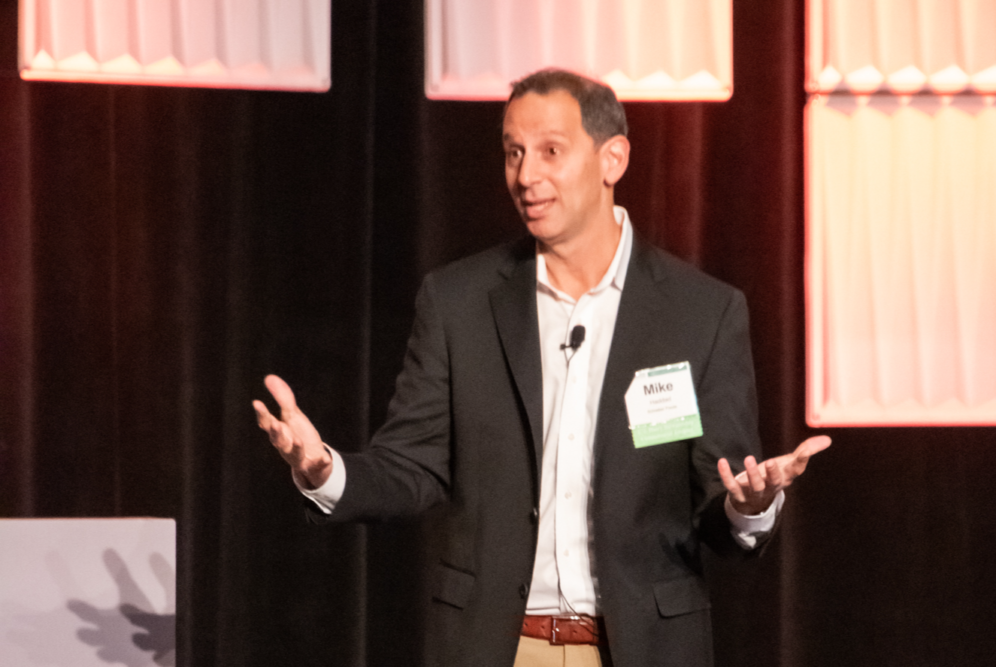GLENDALE, Ariz. – Leaders in the dairy industry came together to discuss how USDA Partnerships for Climate-Smart Commodities projects can help secure a climate-smart and profitable future for farmers during the Dairy Sustainability Alliance Fall Meeting in Glendale, Ariz.
The Alliance, formed through the checkoff-founded Innovation Center for US Dairy, consists of companies and organizations across the dairy community and others who want to contribute to dairy’s social responsibility journey. Nearly 300 industry stakeholders, including about 30 farmers, attended the Nov. 15 meeting.
Mike Haddad, chair of the Innovation Center for US Dairy and former president and chief executive officer, Schreiber Foods Inc., opened the meeting with a message of how industry unity and alignment on sustainability goals can help secure a bright future for dairy.
“What we’re truly, ultimately after is trust,” Haddad said. “Nobody wants to consume our products just because we tell them, ‘these are so efficiently produced and we can’t believe the yields we got.’ They don’t care about that. What they want to know is that we took care of our animals, our earth and our communities along the way and we can prove it. It takes us all working together to do that.
“One of our Innovation Center guiding principles is that we are better together. We will go faster by teaching and learning and challenging each other. As an Alliance, we should share freely our best practices so dairy can be seen as a sustainability solution.”
The Alliance meeting provided insights into the USDA Partnership for Climate Smart Commodities grants totaling up to $2.8 billion for 70 projects announced in September. The projects that include dairy will provide technical and financial assistance for farmers, support the development of expanded markets and revenue streams, and help the industry make progress toward its collective 2050 Environmental Stewardship Goals at the field and farm levels.
The meeting’s opening panel featured lead partners who previewed their projects and the goals they hope to achieve. The California Dairy Research Foundation, in partnership with 20 other organizations, including Dairy Cares, was among the projects selected. Michael Boccadoro, executive director of Dairy Cares, said the project was selected to receive an approximate funding ceiling of $85 million that will be enhanced with an additional $40 million from the state of California. The project will support efforts to build climate-smart dairy markets and provide financial incentives for the state’s farmers to adopt manure management practices that reduce methane emissions and manage nitrogen.
“It’s a tremendous project that is going to build on and leverage the real unique efforts California has initiated in dairy methane reduction,” Boccadoro said. “We’ve been working on this since 2016 and we have made tremendous progress reducing over 2 million metric tons of methane in the dairy sector.”
Another project led by Wisconsin-based Edge Dairy Farmer Cooperative was selected to receive an approximate funding ceiling of $50 million to expand climate-smart markets and establish dairy and sugar as climate-smart commodities through the implementation of new production practices. Tim Trotter, CEO of Edge Dairy Farmer Cooperative, said the co-op’s commitment to sustainable practices starts with farmer input.
“We are blessed to have a visionary membership who about six years ago decided sustainability is a topic we want to address,” Trotter said. “What we looked at was how can we build this from the ground up? We want the farmers to be centric in the conversation and be engaged with the conversation and make the best decisions for them, so we need to check all boxes.”
Lisa Watson, social responsibility officer of the Innovation Center, offered an update on the US Dairy Stewardship Commitment, launched in 2018 to support farmers, cooperatives and processors who voluntarily work across the industry to advance sustainability leadership and transparently report progress. Commitment terms of adoption are reviewed every 3 to 5 years for consistency with the latest science, insights and priorities. Commitment adopters represent more than 75% of US milk production.
Watson thanked the companies that are part of the Commitment for “raising all boats for US dairy.”
“The Commitment helps us earn the trust of stakeholders, achieve aggregate reporting and demonstrate that U.S. dairy is a true global sustainability leader,” Watson said. “The metrics within the Commitment are aligned with global standards and protocols that help us gain credibility for our work. Through the Commitment, we can say with confidence that U.S. dairy farmers and processors are making a real difference and moving the needle toward achieving the Sustainable Development Goals of the United Nations.”
The meeting featured other sessions focused on:
- Scientific evidence that shows feed additives carry potential in reducing enteric methane emissions from dairy cattle.
- The checkoff’s work in helping to create a program that integrates agriculture literacy into national high school science, technology, engineering and math (STEM) standards.
- Dairy’s role in helping to nourish 34 million Americans facing food insecurity, including 9 million children, with insights from Feeding America leaders.
- How stakeholders across the dairy value chain are taking decisive action to improve water management in the face of economic and environmental uncertainties.
Dairy Farmers Participate in Sustainable Agriculture Summit
The Sustainable Agriculture Summit followed the Alliance meeting, which featured more than 700 farmers, suppliers, processors, brands, academia, conservation organizations and the public sector and is produced in partnership by the Innovation Center for US Dairy and Field to Market.
The dairy industry was represented on several parts of the Summit’s agenda, including a panel discussion moderated by New Mexico producer Tara Vander Dussen, who also is an environmental scientist and co-founder of Elevate Ag. The discussion centered on how western farmers, including Jim Boyle, Jr. of Casa Grande Dairy in Arizona, are advancing sustainability, while highlighting challenges they face and the need for industry-wide collaboration that can build economically viable pathways.
For information about the industry’s sustainability work and the dairy checkoff, visit www.usdairy.com.

